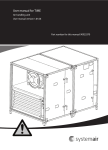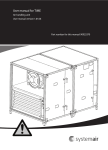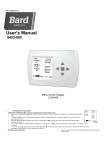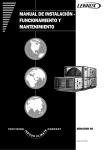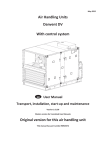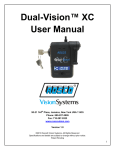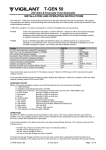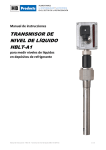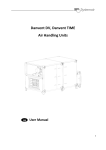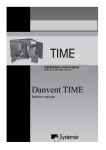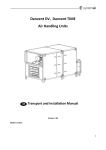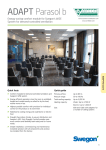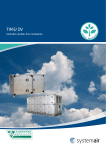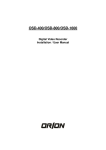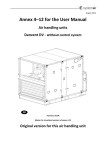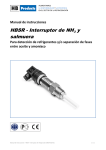Download Air Handling Units Danvent DV, Danvent TIME With
Transcript
July 2014 Air Handling Units Danvent DV, Danvent TIME With control system GB User Manual Version 1.01.04 Master version for translated User Manuals Original version for this air handling unit 1 Detailed table of contents on the following pages General description a. Manufacturer b. Name of machines c. Declaration of conformity ‐ example d. General descriptions, dangers and warnings e. Drawings, diagrams, guides and instructions for use, maintenance, repairs f. Employees in charge of operation/control/maintenance g. Intended use and applications h. Unintended use and misuse – inappropriate applications for the machine Installation i. Instructions for unloading on the site, installation and connection j. Installation and assembly instructions for reduction of noise and vibrations Start‐up, adjustments and operation k. Start‐up, adjustments, use and commissioning l. Residual risks that remain m. Instructions on the protective measures during repair and maintenance n. Tools which may be fitted to the machinery Machine stability o. Stability during use, transportation, assembly, dismantling when out of service p. Machinery where these are regularly to be transported Breakdown q. Operating method in the event of breakdown. Safe restart. Maintenance r. Adjustment and maintenance operations s. Adjustments and maintenance to be carried out safely t. Spare parts to be used, when these affect health and safety Noise u. Information on airborne noise emissions exceeding 70 dB(A) Annexes 1. Declaration of conformity with production number 2. Technical data – unique data for every unit 3. Spare part list 4. Assembly of base frame – height 150 mm for unit sizes 10 – 40 5. Assembly of base frame – height 150 mm for unit sizes 50 – 150 6. Assembly of base frame – height 250 mm for unit sizes 10 – 40 7. Assembly of base frame – height 250 mm for unit sizes 50 – 150 8. Installation of steel roof in the sizes 10‐150 9. Rotary exchanger – speed control and assembly of divided rotor 10. Internal controller in the cooling compressor units – DVU and DVU‐C 11. Menu for internal controller in the cooling compressor units ‐ DVU and DVU‐C 12. Connection of fan motor and set‐up manual for Danfoss VLT FC101 frequency converter 13. Commissioning protocol ‐ proposal 14. Report with data from final functional test on the Systemair factory 15. Short description of main components in the control system 16. Wiring diagram 17. Operator’s guide (how to use the Systemair control panel) 2 Contents A.MANUFACTURER 9 B.NAMEOFMACHINES 10 C.DECLARATIONOFCONFORMITY‐EXAMPLE 11 D.GENERALDESCRIPTIONS,DANGERSANDWARNINGS 12 d.1 Overview via pictograms on the inspection side of the unit d.1.1 Where are pictograms placed on the units d.1.2 CE label – example for DV unit d.1.3 CE label – example for TIME unit d.1.4 Pictogram on a door for a fan in a DV unit d.1.5 Pictogram on a door for a fan in a TIME unit d.1.6 Pictograms for all available functions in the units d.1.7 Pictograms about warnings and dangers on the units 12 13 14 14 14 14 15 16 d.2 Data about the unit according to cards and labels in and on the unit d.2.1 Machine card with unique data on every unit d.2.2 Label with data about the cabinet d.2.3 Flowchart – example of the label placed on or with the cabinet d.2.4 Symbols in the flowchart and explanation about the symbols. d.2.5 Example of label placed on or with the cabinet – Terminal plan for external components 17 17 18 18 19 20 20 d.3 Hand terminal (optional for DV units – always standard for TIME units) 20 d.4 Dimensions of the units – selected examples. 21 d.5 Ordinary automatically operation – only manual operation by new parameters. 22 d.6 Warnings about dangers 22 E.DRAWINGS,DIAGRAMS,GUIDESANDINSTRUCTIONSFORTHEUSE,MAINTENANCE ANDREPAIR 22 F.EMPLOYEESINCHARGEOFOPERATION/CONTROL/MAINTENANCE f1. Employees that take care of ordinary operation G.INTENDEDUSEANDRANGEOFAPPLICATIONS 23 23 23 3 H.UNINTENDEDUSEANDMISUSE–INAPPROPRIATEAPPLICATIONSFORTHEMACHINE 23 h.1 Air handling unit in operation I.INSTRUCTIONSFORUNLOADINGONTHESITEASWELLASINSTALLATIONAND CONNECTION 23 24 i.1. Unloading on the site i.1.1 Unloading by fork‐lift truck i.1.2 Unloading by crane i.1.3 Transport of unit without base frame on the site i.1.4 Lifting a unit with straps i.1.5 Lifting a unit with preinstalled brackets on the base frame for lifting. i.1.6 Roof unit with bitumen roof i.1.7 Roof unit with steel roof i.1.8 Pre‐assembly storage i.1.9 Tilt less than 30˚ during transportation of the section with cooling compressor – DVU or DVU‐C 24 24 24 24 24 25 25 25 26 26 i.2. Installation ‐ mechanical i.2.1 Free area in front of and above the unit i.2.2 Supporting surface i.2.3 Adjustable feet under legs or base frame and transport of sections i.2.4 Base frame assembly i.2.5 Base frames for outdoor units i.2.6 Installation on the site of unit sections at the base frame when sections are delivered on pallets. i.2.7 Joining the AHU sections i.2.8 Fitting the ductwork i.2.9 Risk of stack effect by vertical ducts and wind pressure on louvers i.2.10 Refitting of guards 26 26 26 26 26 27 27 29 30 30 30 i.3. Installation ‐ electrical 31 i.3.1 Description 31 i.3.2 Wiring diagrams 31 i.3.2.1 TIME units ‐ labels on the cabinet next to the supply fan 31 i.3.2.2 DV units – labels on or with the cabinet 31 i.3.3 Installation of mains power supply 31 i.3.3.1 Necessary mains power supply for TIME units with ec motors and without DVU 31 i.3.3.2 Necessary mains power supply for DV units with cabinet/control system 32 i.3.3.3 Necessary overvoltage protection device, that leads lightning overvoltage to an earth lead on a safe way. 32 i.3.4 Electrical connection of components and functions 32 i.3.4.1 Connection of the Systemair Control Panel to the Corrigo E28 controller – software version 3.3 32 i.4 Installation – Pipes for water – hot and chilled, valves and drains i.4.1 Description i.4.2 Pipe connections i.4.3 Possibility of extracting components from the unit i.4.4 Pipe connections to batteries 33 33 33 33 33 4 i.4.4.1 Heating coils i.4.4.2 Cooling coils i.4.4.3 Rigid bearings for valves, circulation pumps and pipe system i.4.4.3.1 Pipe connection to heating coils i.4.4.3.2 Pipe connection to cooling coils for chilled water i.4.4.3.3 Valve motor and valve for heating i.4.4.3.4 Valve motor and valve for cooling i.4.5 Draining condensate water i.4.6 Draining condensate water from plate heat exchanger i.4.7 Draining condensate water from cooling battery 33 34 34 34 35 35 35 35 36 36 J.INSTALLATIONANDASSEMBLYINSTRUCTIONSFORREDUCTIONOFNOISEAND VIBRATIONEMISSIONS 36 K.INSTRUCTIONSFORPUTTINGINTOSERVICE,ADJUSTMENTS,USEAND COMMISSIONING. 37 k.1 Print‐outs on paper 37 k.2 Electronic media 37 k.3 Documentation is available for download from https://techdoc.systemair.dk 38 k.4 Start‐up by installer k.4.1 Checklist, relevant values k.4.1.1 Checklist prior to start‐up k.4.1.2 Switch on power 38 38 38 38 K.5 Adjustments and use 38 K.6 Description of functions K.6.1 Remote control k.6.1.1 Communication WEB‐master (TCP/IP Exoline) to PC and Android telephone k.6.1.2 Communication to BMS systems with MODBUS k.6.1.3 Communication to BMS systems with LON k.6.1.4 Communication to BMS systems via BACnet K.6.2 Extended operation and external start/stop (for example by presence detectors) k.6.3 Valve and valve motor for heating coil k.6.4 Valve and valve motor for cooling coil k.6.5 DX cooling k.6.6 Circulation pump, heating k.6.7 Fire alarm function k.6.7.1 External fire signal that indicate block or run k.6.7.2 External fire signal k.6.7.3 Two fire thermostats k.6.7.4 One smoke detector in extract air k.6.8 E tool ‐ configuration tool k.6.9 Electrical heater battery k.6.9.1 Control of heating capacity connected to unit with Systemair control system 38 38 38 39 39 39 39 39 39 39 39 40 40 40 40 40 40 40 40 5 k.6.9.2 Control of heating capacity connected to unit without Systemair control system k.6.10 Speed control of fans k.6.10.1 TIME control system – EC motors k.6.10.2 DV control system ‐ frequency converters inside the unit are IP 20 k.6.10.3 Pressure transmitters k.6.10.4 CO2‐dependent air flow k.6.10.5 Humidity dependent air flow k.6.11 Cabinet k.6.11.1 Integrated cabinets in TIME units k.6.11.2 Integrated cabinet in DV units with control system k.6.11.3 Cabinet placed on the DV unit with control system k.6.12 Temperature sensors k.6.13 Damper motors k.6.14 Filter guards k.6.15 Room temperature sensors k.6.16 Frost protection k.6.17 Systemair Control Panel ‐ SCP k.6.18 Cooling recovery k.6.19 Free cooling k.6.20 Alarm signal k.6.21 Heat recovery k.6.22 Frost protection – plate heat exchanger k.7 Commissioning 40 41 41 41 41 41 41 41 41 41 41 41 42 42 42 42 42 42 42 43 43 43 43 L.INFORMATIONABOUTTHERESIDUALRISKSTHATREMAINDESPITETHEINHERENT SAFEDESIGNMEASURES,SAFEGUARDINGANDCOMPLEMENTARYPROTECTIVE MEASURESADOPTED. 43 l.1 Unit casing. l.1.1. Design of the machine to make transport safe 43 43 l.2 Common for all unit sections l.2.1 Risk caused by surfaces, edges and corners 43 43 l.3 Common for all unit sections by insufficient lighting l.3.1 Risk caused by insufficient lighting inside sections 44 44 l.4 Dampers type DVA – DVB – DVM – DVP – Bypass dampers in DVQ l.4.1 Risk caused by maintenance and cleaning of dampers 44 44 l.5 Attenuators type DVD l.5.1 Risk caused by maintenance and cleaning of attenuators 44 44 l.6 Filters type DVG – DVF l.6.1 Risk caused by missing change of filters l.6.2 Risk caused by the execution of filter change 44 44 45 l.7 Plug fans type DVE 45 6 l.7.1 Risk caused by lightning strike l.7.2. Risk caused by permanent magnet motor l.7.3 Risk of rotating impeller caused by stack effect (chimney effect). 45 45 45 l.8 Batteries for heating and cooling type DVR – DVH – DVK, cooling compressor l.8.1 Extreme temperatures ‐ heating l.8.2 Extreme temperatures ‐ cooling 46 46 46 l.9 Cooling compressor units type DVU – DVU‐C l.9.1 Risk of high temperature l.9.2 Risk caused by lightning strike 46 46 46 M.INSTRUCTIONSONTHEPROTECTIVEMEASURESTOBETAKENBYALLSERVICE TECHNICIANSDURINGREPAIRANDMAINTENANCE 46 N.THEESSENTIALCHARACTERISTICSOFTOOLSWHICHMAYBEFITTEDTOTHE MACHINERY 47 O.THECONDITIONSOFSTABILITYDURINGUSE,TRANSPORTATION,ASSEMBLY, DISMANTLINGWHENOUTOFSERVICE 47 o.1 Installed reliable to avoid units to be tilted or moved by the any storm. 47 o.2 Transport of section with cooling compressor unit 47 o.3 Disposal of the cooling compressor system ‐ type DVU and DVU‐C 47 o.4 Generel disassembly – sharp edges 47 P.INSTRUCTIONSFORMACHINERYWHERETHESEAREREGULARLYTOBE TRANSPORTED 48 Q.THEOPERATINGMETHODTOBEFOLLOWEDINTHEEVENTOFBREAKDOWN.SAFE RESTART. 48 R.ADJUSTMENTANDMAINTENANCEOPERATIONS 48 r.1 Shutdown of the unit to a safe state. 48 r.2 Recommended maintenance intervals 49 r.3. Filters – sizes and numbers r.3.1 Bag filters r.3.2 Panel filters 50 51 51 r.4. Changing the Internal Battery in the controller 51 7 r.5 Other functions to maintain r.5.1 The unit r.5.2 Dampers r.5.3 Rotary heat exchanger DVC r.5.3.1 Rotor r.5.3.2 Motor and belt drive r.5.4 Cross flow and counter flow exchanger r.5.4.1 By‐pass damper r.5.4.2 Condensate water drain r.5.5 Run‐around heat exchanger DVR r.5.5.1 Pump and pressure expansion r.5.5.2 Condensate water drain r.5.6 Heating coil DVH, cooling coil DVK and change over coil DVHK r.5.6.1 Heating battery r.5.6.2 Cooling battery r.5.6.3 Electeric heating battery r.5.7 Plug fans DVE r.5.7.1 Motor r.5.8 Silencer DVD r.5.9 Outdoor air section DVY r.5.10 Cooling compressor units DVU and DVU‐C r.5.10.1 Cooling compressor circuit r.5.10.2 Built‐in control system r.5.10.3 Maintenance of built‐in control system 52 52 52 53 53 53 53 54 54 54 54 54 55 55 55 55 55 55 55 56 56 57 57 57 S.INSTRUCTIONSDESIGNEDTOENABLEADJUSTMENTANDMAINTENANCETOBE CARRIEDOUTSAFELY,INCLUDINGTHEPROTECTIVEMEASURESTHATSHOULDBE TAKENDURINGTHESEOPERATIONS 57 s.1. Protective measures and additional protective measures s.1.1 Necessary protection measures prior to start‐up. s.1.1.1 Design of protection measures s.1.1.2 Configuration of frequency converters with installed guard s.1.2 Safe adjustment and maintenance s.1.3 Personal protective equipment for maintenance staff – health and safety 57 58 58 58 58 58 T.THESPECIFICATIONSOFTHESPAREPARTSTOBEUSED,WHENTHESEAFFECTTHE HEALTHANDSAFETYOFOPERATORS 59 t.1 Spare parts ‐ Mechanical 59 t.2 Spare parts ‐ Electrical 59 U.INFORMATIONONAIRBORNENOISEEMISSIONSEXCEEDING70DB(A) 59 ANNEX1DECLARATIONOFCONFORMITYWITHUNIQUEPRODUCTIONNUMBER. 59 8 ANNEX2TECHNICALDATA–UNIQUEDATAFOREVERYUNIT 59 ANNEX3SPAREPARTLISTS 59 ANNEX4–12AREPRINTEDASASEPARATEMANUALASSUPPLEMENTTOTHISUSER MANUAL 59 ANNEX13COMMISSIONINGPROTOCOL–PROPOSAL(RECEIPTFORHAND‐OVER) 59 ANNEX14REPORTWITHDATAFROMTHEFINALFUNCTIONALTESTONTHE SYSTEMAIRFACTORY 60 ANNEX15SHORTDESCRIPTIONOFMAINCOMPONENTSINCONTROLSYSTEM 60 ANNEX16WIRINGDIAGRAM 60 ANNEX17OPERATOR’SGUIDE(HOWTOUSETHESYSTEMAIRCONTROLPANEL) 60 9 a.Manufacturer This User Manual covers all air handling units with control system delivered by Systemair A/S. Manufacturer and supplier data: Systemair A/S Ved Milepælen 7 DK‐8361 Hasselager Responsible for documentation: Ulf Bang b.Nameofmachines This manual is about Systemair air handling units with control systems called DANVENT DV10, DANVENT DV15, DANVENT DV20, DANVENT DV25, DANVENT DV30, DANVENT DV40, DANVENT DV50, DANVENT DV60, DANVENT DV80, DANVENT DV100, DANVENT DV120, DANVENT DV150, DANVENT DV190 og DANVENT DV240. and TIMEec 10, TIMEec 15, TIMEec 20, TIMEec 25, TIMEec 30, TIMEec 40 10 c.DeclarationofConformity‐example The manufacturer: Systemair A/S Ved Milepælen 7 DK - 8361 Hasselager Hereby declares that, air handling units of the flowing types: Delivered with control system DANVENT DV10, DANVENT DV15, DANVENT DV20, DANVENT DV25, DANVENT DV30, DANVENT DV40, DANVENT DV50, DANVENT DV60, DANVENT DV80, DANVENT DV100, DANVENT DV120, DANVENT DV150, DANVENT DV190 and DANVENT DV240. TIMEec 10, TIMEec 15, TIMEec 20, TIMEec 25, TIMEec 30, TIMEec 40 Serial No: ”YYMM-71800-X” are manufactured and delivered in accordance with following directives: Machinery directive 2006/42/EC EMC – directive 2004/108/EC Low voltage directive 2006/95/EC Pressure equipment directive 97/23/EC European Standard EN378 Equipment type: DVU-series Consisting of: Compressor, evaporator and condenser Verification and Assessment by: Notified Body Bureau VERITAS CE0041 for PED Bureau VERITAS UK, “Parklands”, Wilmslow Road Didsbury, Manchester M20 2RE Module: A1 Certificate no: CE-0041-PEDA1-SYA-001-10-DNK The declaration is only valid, if the installation of the air handling unit is carried out according to the instructions delivered with the unit. The installer will be responsible for the CE marking and documentation, if any construction or functional changes are applied to the air handling unit. Hasselager 24. June 2013 11 d.Generaldescriptions,dangersandwarnings TIME and DV air handling units are order specific machines available in thousands of different configurations. Only a few examples of machine configurations are described below. The air handling units are intended for the transport and treatment of air between ‐40 °C and + 40 °C The units are exclusively for comfort ventilation. Maintenance of the units must be carried out by skilled technicians. On the drawing below, a right hand unit is shown because the inspection doors are mounted on the right hand side of the unit when looked in direction of SUPPLY airflow. The unit below is with rotary heat exchanger. Position Description Symbol A Connection, supply air (to the rooms) B Connection, exhaust air C Connection, outdoor air in D Connection, extract air (from the rooms) d.1Overviewviapictogramsontheinspectionsideoftheunit 7 8 11A 11B 9 2 1 10 B D C A 3 4 5 6 This is a right hand unit because the inspection doors are mounted on the right hand side of the unit when looked in direction of SUPPLY airflow. 12 d.1.1Wherearepictogramsplacedontheunits Example (Symbols and descriptions of functions for fast identification) Position Description 1 The CE label and the unique production number of this machine 2 Machine card 3 Damper ‐ supply air 4 Filter ‐ supply air Symbol 5 Fan‐ supply air 6 Heating battery ‐ supply air 7 Fan ‐ extract air 8 Rotary heat exchanger 9 Filter – extract air 10 Damper – extract air 11A 3 labels. One label with Flowchart, one label with terminal plan for external components and one label listing data about the cabinet. The labels are placed behind inspection doors, if the cabinet with control system is inside the unit. 3 labels. One label with Flowchart, one label with terminal plan for external components and one label listing data about the cabinet. The labels are placed on the cover of the cabinet, if the cabinet with control system is placed on the top of or on the front of the unit. 11B 13 d.1.2CElabel–exampleforDVunit This is the mandatory informations for the CE marking with; Product name (in this example Danvent DV 20, where 20 informs about the size of the unit), Production number for the complete unit (in this example YYMM‐xxxxx‐x, where YYMM informs about year and month for the manufacture), xxxxx‐x is the unique production number. d.1.3CElabel–exampleforTIMEunit This is the mandatory informations for the CE marking with; Product name (in this example TIME 40, where 40 informs about the size of the unit), Production number for the complete unit (in this example YYMM‐xxxxx‐1, where YYMM informs about year and month for the manufacture), xxxxx‐1 is the unique production number. d.1.4PictogramonadoorforafaninaDVunit Example of the pictogram with the symbol for the function ‐ fan, Systemair product name is DVE‐20‐BK where 20 informs about the size of the unit and BK is Backward Curved fan blades, production number for the complete unit (in this example 73004‐2) and the customer’s name for the unit, always written after – Plant no:____________ d.1.5PictogramonadoorforafaninaTIMEunit Example of the pictogram with the symbol for the function ‐ fan, Systemair product name is this example is ‐ Fan Supply, production number for the complete unit (in this example xxxxx‐1) and the customer’s name for the unit, always written after ‐ Plant no:____________ 14 d.1.6Pictogramsforallavailablefunctionsintheunits Id Description Symbol DVA Damper DVB Damper DVM Damper for mixing DVP Damper for mixing DVG Panel filter DVF Bag filter DVC Rotary heat exchanger DVQ Plate heat exchanger (cross flow and counter flow) DVR Run around heat exchanger DVH Heating battery DVK Cooling battery DVU Integrated cooling with compressor unit 15 DVE Plug fan DVD Silencer DVX Humidifier d.1.7Pictogramsaboutwarningsanddangersontheunits Pictograms according to EN1886 about Warning about danger by rotating parts Warning about danger by electricity Warning about danger by heat 16 d.2Dataabouttheunitaccordingtocardsandlabelsinandontheunit d.2.1Machinecardwithuniquedataoneveryunit An example of a machine card is shown below. 17 d.2.2Labelwithdataaboutthecabinet An example of the label that is always placed on or with the cabinet Systemair A/S Systemair declares hereby that the cabinet is in conformity with: SBB Low voltage N60439‐1 panels: Electrical material on EN60204‐1 machines: EMC‐directive 89/336/EOF environment: Diagram version DV ver. 2.11 Systemair order 72800‐1 number Unit size DV 10‐150 Cabinet data: System ground TN‐S Current type AC Frequence 50 HZ 3*400 Rated voltage V+N+PE VAC Control voltage 24 VDC IK max 6 kA IK min 650 A Max fuse 25 Min fuse 10 Cable colors: Protection circuit Green/yellow 230 VAC phase Black 0 VAC neutral Blue 24 VDC Grey 0 VDC Grey Analog/digital Grey d.2.3Flowchart–exampleofthelabelplacedonorwiththecabinet 18 d.2.4Symbolsintheflowchartandexplanationaboutthesymbols. Id Description RX Temperature sensor ‐ PT1000 Symbol MX Damper motor ‐ on/off MX Damper motor – 0‐10V BX Filter guard ‐ digital PX Pressure transmitter – 0‐10V PX Sensor for relative humidity – 0‐10V PX Sensor for CO2 – 0‐10V T110 Controller for rotary heat exchanger – 0‐10V 19 d.2.5Exampleoflabelplacedonorwiththecabinet–Terminalplanforexternal components d.3Handterminal(optionalforDVunits–alwaysstandardforTIMEunits) The hand terminal is delivered in a cardboard box containing the other external components. This cardboard box is usually, but not always, placed in the section with the supply air fan. The Operator’s Guide for the hand terminal is the annex 17 attached to this – User Manual. 1. ALARM: Press for alarm list 2. Alarm LED – red light for alarm 3. LED indicating change of parameters 4. OK/ENTER 5. Press for clear 6. Press for move of curser in menu Important! All LEDs on the hand terminal must be off before startup of the unit. 20 d.4Dimensionsoftheunits–selectedexamples. Examples on dimensions of selected configurations below. Other configurations have other dimensions. 21 d.5Ordinaryautomaticallyoperation–onlymanualoperationbynew parameters. The unit is operating fully automatically and manual operation includes only selection of new parameters via the buttons on the hand terminal. The hand terminal is connected by a cable to the controller in the cabinet. 10 meters of cable is delivered with the unit and the customer has the possibility to replace this cable with an identical type of cable that is up to 100 meters long. The alternative is that the controller is connected to a BMS system with the ability to select new parameters via PC, tablet, SmartPhone or mobile phone. d.6Warningsaboutdangers Pictograms are according to EN1886 about; Warning about danger by rotating parts Warning about danger by electricity Warning about danger by heat Disregards of instructions shown on warning signs are connected by risk for injury or damage on material. e.Drawings,diagrams,guidesandinstructionsfortheuse,maintenance andrepair All DV units with integrated control system and TIME units are manufactured in compliance with the EC Declaration of Conformity and they are CE marked as machines. Unique Declaration with production number of the machine is an integral part of the machine – enclosed as annex 1 to this manual. If the buyer carries out changes or adds components in or on the machine, the buyer must issue a new EC Declaration of Conformity and a new CE marking of the machine. To promote correct use of the machines, the below‐mentioned instructions are an integral part of the machine: Unique drawings, data and description of functions for the delivered unit – annex 2 Wiring diagrams – annex 16 22 Operator’s Guide – annex 17 Instructions for use of the machine – section k in this manual Instructions about adjustment and maintenance – section r in this manual Safety during adjustment and maintenance – section s f.Employeesinchargeofoperation/control/maintenance The unit is able to operate fully automatically when the installer has started, adjusted and handed over the faultless unit to the staff that takes care of operation, control and maintenance. f1.Employeesthattakecareofordinaryoperation Indications of operation status as well as indication of faults are visible in the display and on the LED’s of the hand terminal. The employees can enter new parameters in the controller via the buttons on the hand terminal. The alternative is that the controller is connected to a BMS system with the ability to select new parameters via PC, tablet, SmartPhone or mobile phone. g.Intendeduseandrangeofapplications The air handling units are intended for the transport and treatment of air between ‐40 °C and + 40 °C The units are exclusively for comfort ventilation and not for air that causes severe corrosion to galvanized steel and to copper and aluminum. The units are not for environments that exceed the corrosion class C4 according to EN ISO 12944‐2. Intended applications for the units are: Offices, teaching rooms, hotels, shops, homes and similar comfort zones. h.Unintendeduseandmisuse–inappropriateapplicationsforthe machine The air handling units are not suitable for transport of air with risk of explosion and with Ex‐Classification. Do not install the units in Ex‐areas at all. Do not install units outdoors unless the units are constructed for outdoor installation. Units not suitable for outdoor installation are units without roof and units with cabinet installed on the unit (the cabinet is installed inside the unit for outdoor installation). The units are not for environments that exceed the corrosion class C4 according to EN ISO 12944‐2, and the units are not for transport of solid particles. Not intended applications for the units are: Kitchen extraction, swimming pools, off‐shore, Ex‐areas, drying of washed clothes. Do not use the unit with partly finished duct systems. Do not use the unit for ventilation of the building site until the unit is properly provided with guards. h.1Airhandlingunitinoperation The pressure difference between interior and exterior of the unit must not exceed 2000 Pa for the DV 10 and up to DV 150 (including DV 150), and 1500 Pa for DV 190 and DV 240. Before start‐up of the unit all ducts, guards and all protective devices must be mounted to prevent any access to rotating fan impellers. All inspection doors must be closed and locked when the unit is in operation. Do not use the unit without filters. 23 i.Instructionsforunloadingonthesiteaswellasinstallationand connection i.1.Unloadingonthesite The air handling unit – AHU ‐ is delivered as one section or in several sections, which are to be assembled on site. The AHU is delivered on transport pallets, legs or on a base frame. Loading and unloading as well as transport on the site is possible by fork‐lift truck or by crane using suitable lifting straps. i.1.1Unloadingbyfork‐lifttruck The forks of the truck must be sufficiently long to avoid any damage to the AHU underside. i.1.2Unloadingbycrane AHU delivered on transport pallet must be lifted by straps as shown in the illustration. AHU delivered with legs must be lifted by straps secured to the legs as shown in the illustration. i.1.3Transportofunitwithoutbaseframeonthesite Units without base frame are always delivered in sections with each section on a pallet. Sections can be transported on the site by hand manual forklifts. i.1.4Liftingaunitwithstraps Use an appropriate lifting beam with a sufficient span to avoid that the straps touch and damage the drip nose profiles and the inspection side with handles, pipes and accessories – for example manometers, cabinets, tabs for measuring the pressure. 24 i.1.5Liftingaunitwithpreinstalledbracketsonthebaseframeforlifting. Lifting beam and straps are not included in the delivery. i.1.6Roofunitwithbitumenroof Avoid damaging the drip nose profiles along the bitumen roof. Keep the protection profiles of Styrofoam on the unit until the installation has been completed. If the unit is lifted by straps, the straps must be kept away from the drip nose profiles by bars to avoid damage to roofing profiles. i.1.7Roofunitwithsteelroof For units with steel plate roof, the steel plates are delivered uninstalled on a separate pallet. Do not step or walk on the plates. . 25 i.1.8Pre‐assemblystorage The AHU must be protected from the weather and accidental impact. Plastic packaging must be removed and the unit covered with tarpaulin or similar materials. In order to minimize condensation, sufficient air circulation must be ensured between the covering and the unit. i.1.9Tiltlessthan30˚duringtransportationofthesectionwithcoolingcompressor– DVUorDVU‐C During transportation, the unit section ‐ DVU or DVU‐C‐ must always be in the upright position or tilted less than 30˚. If it is necessary to tilt the unit more than 30˚, the suction pipe of the compressor must point upwards to prevent the escape of oil from the compressor sump. i.2.Installation‐mechanical i.2.1Freeareainfrontofandabovetheunit Important! When positioning the unit on the site, it must be ensured that an area with the same width as the unit is kept free for service and inspection and also for replacement of fans and exchanger, if needed. The width of the free area must be at least 900 mm. Important! For safe access to the cabinet with electrical components, if the cabinet is placed on top of the unit, the free area from the upper edge of the cabinet to the ceiling must be at least 700 mm. i.2.2Supportingsurface The surface beneath the unit must be level, horizontal and vibration‐free. The surface must be able to withstand the load of the AHU. Weights of the sections are written in Annex 2. Remember! Duct work must be sound insulated and must not be mounted directly on beams, trusses or other critical building parts. i.2.3Adjustablefeetunderlegsorbaseframeandtransportofsections Adjustable feet are provided in a carton box placed inside the unit. Adjustable feet are delivered for indoor units and not for outdoor units. Sections can be transported on the site by hand manual forklifts or similar. The frame profiles in the edges of the sections have carrying capacity for lifting by the hand manual forklifts. i.2.4Baseframeassembly The base frame is delivered unassembled and has to be assembled on the site before it is possible to position and assemble the various sections of the AHU. Assembly of the base frame is illustrated on 4 pages in a manual that is always in a plastic folder and is attached to one of the large base frame parts. This manual is available on the site among the base frame parts. There are two types of base frames: 1. 150 mm high base frames 2. 250 mm high base frames 26 There are 4 different manuals and each of them illustrates the assembly of the 4 different types of base frames: 1. Manual about the 150 mm high base frames for AHUs in the sizes from DV 10 to DV 40. The name of this manual is – Base frame 150 DVZ 10 ‐ 40 2. Manual about the 150 mm high base frames for AHUs in the sizes from DV 50 to DV 150. The name of the manual is – Base frame 150 DVZ 50 ‐ 150 3. Manual about the 250 mm high base frames for AHUs in the sizes from DV 10 to DV 40. The name of the manual is – Base frame 250 DVZ 10 ‐ 40 4. Manual about the 250 mm high base frames for AHUs in the sizes from DV 50 to DV 150. The name of the manual is – Base frame 250 DVZ 50 ‐ 150 Example of 150 mm high base frame for AHUs in the size from DV 50 to DV 150 Mount adjustable feet with a distance of maximum 1500 mm between each foot under the base frame. The base frame can now be levelled by the adjustable feet. The next step is to place and assemble AHU sections on the base frame. i.2.5Baseframesforoutdoorunits Outdoor units must be installed on 250 mm high base frames and are always fitted to the AHU sections. Hot‐dip galvanized base frames are recommended for outdoor units. Systemair delivers these base frames without the above mentioned adjustable feet. i.2.6Installationonthesiteofunitsectionsatthebaseframewhensectionsare deliveredonpallets. Lift up the section by hand manual forklifts to the level where the underside of the section is even with the overside of the base frame. 1. Pull the section to the correct position on the base frame by lifting straps – it is maybe necessary to support the section by heavy duty furniture trolleys (see the photos below) Example of heavy duty furniture trolley turned with the wheels upwards. Placed in this way on the forks of the hand manual forklifts the heavy duty furniture trolleys are suitable for safe and careful rolling of the unit sections over to the base frames. 27 Example of very heavy duty furniture trolleys. Turned with the wheels upwards and placed on the forks of hand manual forklifts these heavy duty furniture trolleys are very suitable for safe and careful rolling of the unit sections over to the base frames. 2. Pull sections together with lifting straps. We recommend the below shown type of brackets because this type is not damaging the frame profiles of the units. An example of lifting straps is shown below. 28 3. Sections are mounted to base frames with long self‐drilling screws. The frame profile under the inspection doors is placed over the horizontal profile of the base frame. See the example on the photo below. i.2.7JoiningtheAHUsections The sections must be placed on the base frame and if the unit is delivered with 100 mm legs, the sections must be positioned directly opposite each other. 1. Ensure that the internal factory‐fitted rubber sealing is undamaged 2. The sections are then to be positioned directly opposite each other. If the sections are built with legs, the adjustable feet can be used to get the sections parallel and at the same height. 3. Press the sections hard together so that the rubber profiles are so flat that the iron frames of the two sections are joined. Straps with tensioner as shown below are suitable for pressing the sections hard together. 4. The sections are then to be locked permanently together with the black plastic‐coated Systemair Disc‐Locks. The Disc‐Locks are delivered in a carton box placed inside the unit. Place each Disc‐Lock over the 2 factory fitted locking pins. The discs and locking pins are not reliable for pulling the sections together. They are only sufficient for keeping the sections well together, so just turn each disc gently with the supplied Allen key. Use a sequence where each disc is tightened with only one click at a time. If the unit is placed too close to a wall with no space left for the mounting of Systemair Disc‐Locks, brackets must be placed inside the unit to keep the sections permanently together (brackets for this purpose are not delivered by Systemair) 29 i.2.8Fittingtheductwork Flexible duct connections between AHU and ductwork must always be installed. Be sure that flexible duct connections are almost fully stretched. (Flexible connections are ordered as accessories and they are placed inside the unit). At the fan outlet on a centrifugal fan, the duct size should be as close to the outlet size as possible. Avoid blockage and turbulence at the fan outlet. i.2.9Riskofstackeffectbyverticalductsandwindpressureonlouvers On special occasions stack effect – also called chimney effect – in the ducts create airflows that drives the impellers by turned off motors. A rotating impeller is a potential hazard during cleaning and maintenance of the unit. Eliminate this airflow by dampers with spring return motors for automatic closing of the dampers ‐ even by power failure. Important! The Systemair air handling units can be ordered and delivered without dampers, and the installer/user must check that duct systems with the described risk of stack effect (chimney effect) will be provided with dampers and spring return motors. i.2.10Refittingofguards The guard is a safety guard installed inside the door. Tools are necessary for the removal of the guard. If the guard has been demounted during the installation on the site, the guard must be refitted before startup of the unit. 30 Insert the edges of the guard in the frame profile in the groove that is in the frame profile, and connect both parts of the guard at the middle with 2 screws. Replace the vibration damping foam rubber list if it is damaged. i.3.Installation‐electrical i.3.1Description The position of components is shown and described in annex 2. Connections to terminals are shown in the wiring diagram – annex 16. When control of constant pressure in the ducts (also called demand controlled capacity) is required, the pressure transmitters must measure in the duct system at places where all pressure changes can be registered accurately for reliable pressure control. This placement is left to the customer’s free choice. It is important to achieve a constant pressure – also for the most faraway diffusers. i.3.2Wiringdiagrams The wiring diagrams are printed in separate manuals delivered with the units as annex 16. The wiring diagrams are not unique for the order specific units, but it is standard wiring diagrams with data about all configurations of the units. Hereby the wiring diagrams will inform about components that are not ordered and delivered. See the order confirmation and annex 2 with exact information about the accessory components that are ordered and delivered. The wiring diagram includes: General description, Circuit diagrams, Cabinet layout, Terminal matrix and Cable plan. The wiring diagrams are on the DVD delivered with every unit. i.3.2.1 TIME units ‐ labels on the cabinet next to the supply fan Label with data about the cabinet – including data about fuses – see section d.2.2 Flowchart – see section d.2.3 – standard and not unique for the order specific unit Label with terminal plan for external components – see section d.2.5 – standard, and not unique for the order specific unit i.3.2.2 DV units – labels on or with the cabinet Label with data about the cabinet – including data about fuses – see section d.2.2 Flowchart – see section d.2.3 – unique for the order specific unit – printed with the unique production number of the unit Label with terminal plan for external components – see section d.2.5 – standard, and not unique for the order specific unit i.3.3Installationofmainspowersupply An AC/DC residual current device must be installed in the power supply. The power supply for the units is 3*400 V + N + PE ‐ 50 Hz. Protection of the units in accordance with the local statutory requirements for the additional protection of systems with frequency converters. i.3.3.1 Necessary mains power supply for TIME units with ec motors and without DVU Necessary mains power supply in the table below and in the wiring diagram in annex 16. This information is also printed on the unique machine card placed on the front of every unit (see example of a machine card in section d.2.1). 31 Unit Motor TIME 10 2*0.94 kW 2*0.99 kW 2*0.99 kW 2*1.7 kW 2*1.7 kW 2*3.0 kW 2*3.0 kW 2*2.73 kW 2*2.73 kW 2*5.18 kW 2*5.18 kW 2*4.7 kW TIME 15 TIME 20 TIME 25 TIME 30 TIME 40 Fuse Minimum 10A Fuse Maximum 16A Maximum Short‐circuit current 16kA 10A 13A 13A 25A 16kA 25A 16kA 13A 13A 20A 25A 16kA 32A 16kA 20A 20A 32A 16kA i.3.3.2 Necessary mains power supply for DV units with cabinet/control system Necessary mains power supply is printed on the unique machine card placed on the front of every unit (see example of a machine card in section d.2.1). i.3.3.3 Necessary overvoltage protection device, that leads lightning overvoltage to an earth lead on a safe way. The Installer and user must be aware of the fact that lightning strikes make a risk that requires installation of overvoltage protection devices to lead the lightning overvoltage to an earth lead in a safe way. Installer and user must take care of this according to local statutory requirements. i.3.4Electricalconnectionofcomponentsandfunctions External components and functions are delivered according to the order confirmation. Cable number’s are written on the cables, on the label with terminal plan on or with the cabinet – see section d.2.5 and in the wiring diagrams – annex 16. i.3.4.1 Connection of the Systemair Control Panel to the Corrigo E28 controller – software version 3.3 The SCP panel – part number S‐208997 for software version 3.3 ‐ is provided with 10 metres of cable and a socket for connection with the controller inside the cabinet. The cable is not pulled through the cable entry in the cabinet, so demount the cable at the back of the Systemair Control Panel ‐ pull the cable through the cable entry in the cabinet ‐ adjust the length of the cable and remount the cable in the panel, or add more cable – up to 100 m of cable between the Systemair Control Panel and the controller is possible. Place the Systemair Control Panel on the outer side of the unit or on a wall. 32 Position Description 1 Alarm button: Press for alarm list. 2 Alarm indicator: Flashing for unacknowledged alarm. 3 Write enable LED: Slow flashing indicates parameters can be changed. 4 OK button: Press to activate a selected menu/setting, if possible. 5 Button for clear: Abort a parameter setting or – if possible ‐ restore the original value. 6 7 Right/left – and up/down buttons: Used for navigation up and down and to the right and left in the menu tree. Up/down buttons are also used for increasing or decreasing values of parameters. Holes for mounting 8 Terminal block 9 No cable on terminal 5 for software version 3.3 (illustrated with number 9 on the above drawing) 10 Brown cable on terminal 4 for software version 3.3 (illustrated with number 10 on the above drawing) 11 Yellow cable on terminal 3 for software version 3.3 (illustrated with number 11 on the above drawing) 12 White cable on terminal 2 for software version 3.3 (illustrated with number 12 on the above drawing) 13 Black cable on terminal 1 for software version 3.3 (illustrated with number 13 on the above drawing) i.4Installation–Pipesforwater–hotandchilled,valvesanddrains i.4.1Description If ordered with the unit, the valves and valve motors are stored in a carton box placed inside the unit. Water trap(s) – standard or optional ‐ is (are) necessary to ensure escape of water from the tray under plate heat exchanger and (or) cooling coil. Water trap(s) is (are) stored in a carton box placed inside the unit. i.4.2Pipeconnections Connection pipes on heating‐ and cooling coils are provided with external thread. Drainage outlets on drip trays are provided with external thread. i.4.3Possibilityofextractingcomponentsfromtheunit Pipes and cables must not obstruct the inspection doors and components which can be extracted from the unit. Potential components for extraction are filters, fans and rotary heat exchanger. i.4.4Pipeconnectionstobatteries i.4.4.1 Heating coils Pipes for hot water must be protected by insulation against frost and loss of heat. Further protection against frost can be obtained by installing electrical heating wires around the pipes and under the insulation combined with temperature sensors and a control system. Pipes, insulation, electrical heating wires, control system for heating wires and circulation pump are not delivered by Systemair. 33 i.4.4.2 Cooling coils If ordered with the unit, the valves and valve motors are stored in a carton box placed inside the unit. Pipes for cooling must be protected by insulation against condensation on the pipes and loss of cooling in the summer. Pipes and insulation are not delivered by Systemair. i.4.4.3 Rigid bearings for valves, circulation pumps and pipe system The coil and pipes from the coil are not constructed to withstand the weight and stress from valves, circulation pumps, long pipes and insulation of pipes. The system must be supported carefully in rigid bearings to roof, floor and walls. i.4.4.3.1 Pipe connection to heating coils The heating capacity of the coil with only 2 rows is independent of the connection of the hot water in equal flow or in counter flow to the direction of the air, but connection of the hot water to the pipe marked for inlet and the return water to the pipe marked for outlet is very important to ensure that the sensor for transmission of the water temperature really will be placed in a return circuit of the coil (Screw‐joint for the water temperature sensor is welded in the main collection pipe for return water). For the frost protection of heating coil, the water temperature in the coil is transmitted to the controller The controller always generates a signal to the valve motor that keeps a sufficient flow of hot water to protect the coil against frost. This frost protection is also activated when the running mode is “off”. Coils with 3 rows or more must always be connected in counter flow to the airflow. NOTE: If glycol is added, the glycol must be without additives and auto glycol must not be used.Automatic bleeding has to be installed at the highest point of the 2 pipes — supply or return pipe. If the heating battery is built with 3 or more rows, the water flow must be in counter flow to the direction of the air. To protect against frost a temperature sensor for the transmission of an analog signal to the controller is placed in a pipe on the collection pipe for return water. The sensor must be fitted water tight with a cap in the pipe before water under pressure is in the battery. The pipe for the sensor is soldered on the collection pipe and it is important to hold contra on the pipe, when the cap is tightened. 34 Battery seen from above. The sensor measures the water temperature of the water inside one of the small pipes for return water in the battery. The sensor reduces the area in this pipe and hereby also the flow of warm water in this pipe. The temperature in this pipe is reduced more than the temperature in all other pipes by the airflow through the battery. Because the lowest temperature in the battery probably is measured here, this system creates early and safe warning of frost. It is important that the cap is tightened sufficient to keep the sensor system fully water tight. i.4.4.3.2 Pipe connection to cooling coils for chilled water Coils with 3 rows or more must always be connected in counter flow to the airflow. NOTE: The glycol must be without additives and auto glycol must not be used. Automatic bleeding has to be installed at the highest point of the 2 pipes — supply or return pipe. i.4.4.3.3 Valve motor and valve for heating The valve and valve motor are not installed. 2‐way or 3‐way valve is available. i.4.4.3.4 Valve motor and valve for cooling TThe valve and valve motor are not installed. 2‐way or 3‐way valve is available. i.4.5Drainingcondensatewater Drip trays for collection of condensate water are installed under plate heat exchanger and cooling coil. Each drip tray is provided with a drainage outlet. A water trap is always necessary. To avoid freeze ups and frost bursts of water trap and pipes, sufficient insulation is recommended and installation of heating between the insulation and water trap/pipes could even be necessary (insulation, heating and controller for the heating are not delivered by Systemair). 35 i.4.6Drainingcondensatewaterfromplateheatexchanger Heavy negative pressure where the condensate from the plate heat exchanger is collected in the drip tray allows air to flow through the drainage pipe into the unit and prevents condensate water from flowing out of the unit through the drainage pipe. A water trap with sufficient closing level of the water is extremely necessary to ensure that condensate water flows out of the unit. The pipe diameter of the water trap and sewage system must be identical to the pipe diameter of the drainage outlet from the tray. The closing level of the water trap must be estimated correctly to ensure safe escape of the water (see the illustration and estimate the minimum closing level according to the table). A water trap is optional and installation of the water trap is not included. Negative pressure P (Pa) P H1 Minimum H2 500 Pa 100 mm 40 mm 750 Pa 150 mm 55 mm 1.000 Pa 190 mm 70 mm i.4.7Drainingcondensatewaterfromcoolingbattery If the cooling battery and the drip tray are placed in the unit where negative pressure (under pressure) occurs, the closing level of the water trap must be estimated correctly. See the above‐mentioned information in section i.4.6 – Draining condensate water from the plate heat exchanger. If the cooling battery and the drip tray are placed in the unit where positive pressure (over pressure) occurs, the closing level of the water trap must be estimated correctly as shown on the illustration. A water trap is optional and installation of the water trap is not included. Positive pressure P (Pa) P H1 Minimum H2 500 Pa 90 mm 65 mm 750 Pa 120 mm 90 mm 1.000 Pa 150 mm 120 mm j.Installationandassemblyinstructionsforreductionofnoiseand vibrationemissions Due to the design and construction of the units the (A) weighed sound pressure level from fans and other components do not exceed 70 dB (A) outside the units. Data about sound in annex 2. 36 Installation of the units on springs will reduce the transmission of noise and vibrations to the building. Systemair does not deliver springs for this purpose. Flexible connections between the units and the ducts are available as accessories. k.Instructionsforputtingintoservice,adjustments,useand commissioning. k.1Print‐outsonpaper The documents listed below are always printed on paper and delivered together with the units according to the Machinery Directive and the related national laws This User Manual with; Declaration of incorporation – annex 1 The unique technical data for this unit ‐ annex 2 Installation instructions including instructions for the Danfoss frequency converter – annex 4‐12 Printed form for Commissioning protocol ‐ annex 13 Test report – annex 14 Short description about the main components in the control system – annex 15 Wiring diagrams ‐ annex 16 Operator’s guide for the Systemair control panel ‐ annex 17 k.2Electronicmedia A DVD is delivered with every unit. The below‐mentioned documents are available on every DVD and this means that every DVD is provided with information about many components that are not delivered with every unit. The documents on the DVD: Common This User Manual Operator’s Guide Commissioning Protocol as a Word‐file for modification by the installer Components in the control system Danfoss frequency converter Corrigo controller manuals Information about Building Management Systems Damper motors Filter guards Temperature sensors Fire thermostats Smoke detectors Pressure transmitters Valves Valve motors Humidity sensors CO2 sensor Humidity sensor Humidifier E‐Tool software for fast communication with the Corrigo controller Other 37 k.3Documentationisavailablefordownloadfromhttps://techdoc.systemair.dk Your local Systemair company is able to provide the data or possibly a Password. k.4Start‐upbyinstaller All protection and safety measures must be met before start‐up of the unit. The mains supply voltage must also be checked too. The mains supply voltage must be measured at the supply terminals in the cabinet. k.4.1Checklist,relevantvalues k.4.1.1 Checklist prior to start‐up Is the unit assembled correctly with its functions in the correct order? See annex 2. Are the sections and ducts assembled correct? See annex i. Check that fans and anti‐vibration mounts are not damaged after transportation and installation. Is the rotary exchanger turning freely? Are safety guards installed correctly? If the unit includes integrated cooling (DVU), check whether it is installed and supervised by qualified service personnel. If the unit contains Electric air heater, make sure that the supply isolator disconnects with the unit. Ducts ‐ are all ducts installed? External components ‐ are the valve and valve motor installed correctly? Is the circulation pump installed correctly? Is water under pressure in the coil and circulation pump? Are the pressure transmitters installed and connected correctly? (If this is a system with pressure transmitters in the ducts) Main power supply: o Connected correctly? (3x400 V + N + PE) o Test of supply voltage for actuators and control signal! o Are control signals for actuators connected correctly? k.4.1.2 Switch on power Do not start until all safety procedures have been completed and ensure that inspection doors are closed and locked. Switch on power and the unit should be ready for the start‐up. For start‐up see the Operator’s guide for the Systemair control panel ‐ annex 17 (this manual is delivered with the unit – printed on paper and also available on the delivered DVD). K.5Adjustmentsanduse Adjust the factory set values for parameters on the Systemair Control Panel or via the software E‐Tool on a PC. See the Operator’s guide for the Systemair control panel ‐ annex 17 (this manual is delivered with the unit – printed on paper and also available on the delivered DVD. Further information about the controller is available on the 100 pages in the Corrigo E28 User Manual that is available on the delivered DVD. E‐Tool software is also available on the delivered DVD and for download from a homepage. K.6Descriptionoffunctions K.6.1Remotecontrol k.6.1.1 Communication WEB‐master (TCP/IP Exoline) to PC and Android telephone 38 The controller has been prepared with a WEB‐master interface (WEB side integrated) available when connected to a LAN network. It is possible via the LAN network to read values and to change some parameters – for example set‐point temperatures, schedules, air flow capacity. It is possible to read and reset present alarms. There are 2 levels of login. k.6.1.2 Communication to BMS systems with MODBUS The controller has been prepared for communication via RS485 communication port to a MODBUS based BMS system (Building Management System). The controller can work as a stand‐alone system without any support from other controllers. Special setup of the controller for communication with the BMS system is not included in the delivery from Systemair. k.6.1.3 Communication to BMS systems with LON The controller has been prepared for communication via LON communication port to BMS systems (Building Management Systems).The port uses LonWorks according to the LonMark‐guidelines. The LON‐ interface variables are available from Systemair. The controller can work as a stand‐alone system without any support from other controllers. Special set‐up of the controller for communication with the BMS system is not included in the delivery from Systemair. k.6.1.4 Communication to BMS systems via BACnet The controller has been prepared for BACnet TCP/IP interface. This can be used for communication with a BMS system (Building Management System). The controller can work as a stand‐alone system without any support from other controllers. Special set‐up of the controller for communication with the BMS system is not included in the delivery from Systemair. K.6.2Extendedoperationandexternalstart/stop(forexamplebypresencedetectors) When the unit is running at reduced speed or is in shutdown mode, it can be forced up one step by using a Push button (impulse). The required number of minutes for the extended operation must be selected on the Systemair Control Panel. Button and cable are not delivered by Systemair. Furthermore when the unit is in shutdown mode it is possible to start/stop the unit by presence detectors. Presence detectors and cable are not delivered by Systemair. k.6.3Valveandvalvemotorforheatingcoil The supply voltage for the water valve actuator is 24V AC, the control signal is 0‐10 V. The sensor for water temperature has to be installed in the heating coil and the sensor is provided with cable but not connected to the terminals in the cabinet. The cable between valve motor and terminals in the cabinet is not delivered by Systemair. Standard valves are available for 2 or 3‐way connection. k.6.4Valveandvalvemotorforcoolingcoil The supply voltage for the water valve actuator is 24V AC, the control signal is 0‐10 V. Cables between valve motor and terminals in the cabinet are not delivered by Systemair. Standard valves are available for 2 or 3‐ way connection. k.6.5DXcooling A DX‐cooler can be connected to the controller. Input and output are available for: Start cooling – Alarm cooling – Cooling Y3. Cables are not delivered by Systemair k.6.6Circulationpump,heating Circulation pump is not included in the delivery from Systemair. If the pump has not been activated for 24 hours, the pump is exercised once daily for 1 minute to keep the pump in a good condition. Cables are not delivered by Systemair. 39 k.6.7Firealarmfunction k.6.7.1 External fire signal that indicate block or run The unit is available without components for this function. The controller is as standard configured for ordinary running when the contact is closed (NC). By open contacts the fans stop and the dampers close. If disconnected, fire is indicated and the unit will stop until the signal is re‐connected. On the site qualified technicians are able to change the configuration. k.6.7.2 External fire signal The unit is delivered without components for this function. The controller is as standard configured for ordinary running when the contact is closed (NC). By open contacts the fans stop and the dampers close. When the unit has been shut down by a fire signal, the unit has to be restarted on the control panel. On the site qualified technicians are able to change the configuration. k.6.7.3 Two fire thermostats The unit is available with 2 thermostats installed in the unit – 1 in the extract air and 1 in the supply air. The cut‐off temperature in the thermostats is adjustable between 40 and 70˚C. At the factory supply is set at 70˚C and extract is set at 40˚C. The controller is as standard configured to stop the fans and close the dampers if a thermostat is released. On the site qualified technicians are able to change the configuration. k.6.7.4 One smoke detector in extract air The smoke detector has been installed in extract air next to the fan. The controller is as standard configured to stop the fans and close the dampers if the detector is released by smoke. When the unit has been shut down by a fire signal, the unit has to be restarted on the control panel. On the site qualified technicians are able to change the configuration. k.6.8Etool‐configurationtool The installer can download the PC software called E tool from www.regincontrols.com and this software enables the installer to configure and supervise the function of the system via a graphic interface. This software displays all the parameters to be written in a commissioning report (the commissioning report is available as a Word‐file on the CD delivered with the unit). The TCP/IP port in the Corrigo E28 controller is prepared for communication with the E tool software. k.6.9Electricalheaterbattery k.6.9.1 Control of heating capacity connected to unit with Systemair control system Electrical heater installed with separate controller beside the heater. The separate controller is designed for capacity conversion of the 0‐10 V control signal from the main control system. The electric heater is not supplied from the air handling unit cabinet as the cabinet is not designed to supply the heater with power. No power supply cables are connected to the electric heater. The separate controller is without supply disconnecting device k.6.9.2 Control of heating capacity connected to unit without Systemair control system Electrical heater installed with separate controller beside the heater. The separate controller is designed for capacity conversion of the 0‐10 V control signal from the main control system. The heating capacity is adapted in steps. The electric heater is not supplied from the air handling unit cabinet as the cabinet is not designed to supply the heater with power. No power supply cables are connected to the electric heater. The separate controller is without supply disconnecting device. 40 k.6.10Speedcontroloffans k.6.10.1 TIME control system – EC motors Fan motor revolutions are controlled by the EC motors. The EC motors are configured and tested to comply with the data of the unit. k.6.10.2 DV control system ‐ frequency converters inside the unit are IP 20 Fan motor revolutions are controlled by frequency converters, and they are configured and tested to comply with the data for the unit. The frequency converter for each fan motor is installed inside the unit beside the fan motor with cables between motor and converter. In units with complete control system the frequency converters are delivered with system parameters adapted to the motors and the project. k.6.10.3 Pressure transmitters Separate control of the air flow or duct pressure for supply fan and for extract fan. The required air flow or duct pressures with normal as well as reduced capacity are selected on the Systemair Control Panel. The actual pressure is measured by pressure transmitters. PI calculation in the controller continuously transmits the necessary revolutions for the fans to the frequency converters to achieve the required pressure. k.6.10.4 CO2‐dependent air flow The air flow is controlled by a CO2 sensor. High CO2 concentration is equal to higher air flow. Low CO2 concentration is equal to lower air flow. Based on the actual CO2 level and a min/max level, the needed airflow is calculated. The speed of each fan is adjusted via frequency converter. Terminals in the cabinet are available for connection of the sensor. k.6.10.5 Humidity dependent air flow The air flow is controlled by the humidity sensor. High humidity is equal to higher air flow. Low humidity is equal to lower air flow. Based on the actual humidity level and a min/max level the needed airflow is calculated. The speed of each fan is adjusted via frequency converter. Terminals in the cabinet are available for connection of the sensor. k.6.11Cabinet k.6.11.1 Integrated cabinets in TIME units TIME units are delivered with 2 integrated cabinets. One cabinet in the supply fan section and one cabinet in exhaust fan section. Both cabinets are installed behind inspection doors. External components must be connected to terminals in the cabinet in the supply fan section. k.6.11.2 Integrated cabinet in DV units with control system Cabinet is integrated in the unit behind an inspection door. Terminals are installed in the cabinet for all external components. The number of terminals is always adapted to the individual order. k.6.11.3 Cabinet placed on the DV unit with control system The models with the cabinet on the unit are exclusively for indoor installation. Terminals are installed in the cabinet for all external components. The number of terminals is always adapted to the individual order. k.6.12Temperaturesensors Four sensors are always delivered with each unit. See below where the sensors are placed; 1 sensor in the extract air, installed inside the unit 41 1 sensor in the outdoor air, installed inside the unit before the supply air filter on the cold side of the heat exchanger 1 sensor in the supply air to be placed in the supply air duct by the installer 1 sensor in the exhaust, installed inside the unit k.6.13Dampermotors Four different types of damper motors are available; On/off damper motor, not modulating, without spring function. Torque is 20 Nm and run time is 150 seconds On/off damper motor, modulating, without spring function. Torque is 20 Nm and run time is 150 seconds Spring‐return damper motor, not modulating, with spring function. Torque is 20 Nm and run time is 150/16 seconds Spring‐return damper motor, modulating, with spring function. Torque is 20 Nm and run time is 150/16 seconds k.6.14Filterguards Filter guard over pre‐filter and primary filter installed and connected to the controller for display of alarm when the mechanically set limit is exceeded. Filter alarm will be displayed on the Systemair Control Panel. k.6.15Roomtemperaturesensors One or two external room temperature sensors are available. The cabinet has been prepared with additional terminals for connection of the room temperature sensors. The sensors are delivered without cable. The controller calculates an average of the value from the 2 sensors as input for the control. k.6.16Frostprotection For the frost protection of the heating coil, the water temperature in the coil is transmitted to the controller by a temperature sensor in a water return circuit of the coil. The controller always generates a signal to the valve motor that keeps a sufficient flow of hot water to protect the coil against frost. This frost protection is also activated when the running mode is “off”. If the water temperature falls below the set point temperature the fans stop, the dampers close, and an alarm is activated. From Systemair every heating coil for hot water is provided with a little pipe at the collection pipe for the return water. This little pipe is prepared for the installation of the above mentioned temperature sensor for the transmission of the return water temperature to the controller. k.6.17SystemairControlPanel‐SCP The separate cable‐connected (10m) hand terminal with display and buttons – the Systemair Control Panel is always necessary for the normal handling and programming, because the main Systemair E28 controller is without display and buttons. k.6.18Coolingrecovery If the extract air temperature is lower than the outdoor air temperature, and there is a cooling demand in the rooms, the cooling recovery will be activated by reversing the heat exchanger signal. The signal is increased to the cooling recovery by increasing cooling demand. k.6.19Freecooling A temperature sensor has been installed inside the unit in the outdoor air entrance. If the outdoor temperature after midnight is below the room temperature set point and the actual average room temperature is above the set point temperature, the fans start during the summer to cool down the building during night hours. 42 k.6.20Alarmsignal By alarm there are 24 V DC on terminals in the cabinet. Lamps and cables are not available from Systemair. k.6.21Heatrecovery The heat recovery capacity is controlled by modulating speed of the rotor k.6.22Frostprotection–plateheatexchanger To prevent the plate heat exchanger from being blocked and damaged by ice when the outdoor air temperature is very low, the exhaust air temperature from the coldest area after the heat exchanger is transmitted to the controller by a temperature sensor. The dampers are controlled by modulating damper motor or damper motors to reduce the flow of outdoor air through the exchanger and to increase the flow of outdoor air through the bypass duct. By this sequence the risk of ice blocking of the exchanger is reduced and please note the capacity of the heating battery is sufficient for heating this mixture of preheated and not preheated supply air. k.7Commissioning When the installer has completed the installation and wants to hand over the finished installation to his customer for payment the commissioning protocol can be the written receipt for the full ended job. Fill in the blank spaces and sign the proposed commissioning protocol that is annex 13, or fill in the Word‐file with a Commissioning Protocol that is included on the DVD delivered with the unit. l.Informationabouttheresidualrisksthatremaindespitetheinherent safedesignmeasures,safeguardingandcomplementaryprotective measuresadopted. l.1Unitcasing. l.1.1.Designofthemachinetomaketransportsafe Hazards/dangerous area: Incorrect handling during transportation may cause that the unit is dropped. Dangerous incident: If a person is hit by a unit that is dropped, this could in unfortunate circumstances lead to irreversible injury or death. Claim for reduction of danger: Correct handling during transportation is described in this manual. If lifted by fork‐lift truck the forks of the truck must be sufficiently long. Safety measures are also described in this manual by use of crane. Information about weight of each section is also visible. l.2Commonforallunitsections l.2.1Riskcausedbysurfaces,edgesandcorners Hazards/dangerous area: Sharp edges on plates might occur inside the machines as well as sharp edges on frames of dampers. No sharp edges on the outside of the units. Dangerous incident: Cut fingers/hands. Claim for reduction of danger: Risk only exists during maintenance and cleaning. This takes place at least once every year. Use of gloves and helmet is described in this manual. Cut‐resistant gloves for protection against injury from sharp metal 43 plate edges. Use CE‐marked gloves for this purpose. Lamps mounted inside the unit with sufficient lighting reduce the risk of injury. l.3Commonforallunitsectionsbyinsufficientlighting l.3.1Riskcausedbyinsufficientlightinginsidesections Hazards/dangerous area: On the floors of the units there are handles to hold filters, profiles for the carrying of fan motors. Cables are between fan motors and frequency converters. Dangerous incident: By insufficient lighting, the above‐mentioned obstacles are not visible with the risk of stumbling that becomes a fall, leading in unfortunate circumstances to irreversible injury or death. Claim for reduction of danger: Risk only exists during maintenance and cleaning. This takes place at least once every year. According to this manual and in the SystemairCAD software for configuration and selection of accessories, lamps for sufficient lighting inside the units are mandatory according to the latest interpretations of the Machinery Directive by the authorities. Use of helmets reduces the risk of injury. l.4DamperstypeDVA–DVB–DVM–DVP–BypassdampersinDVQ l.4.1Riskcausedbymaintenanceandcleaningofdampers Hazards/dangerous area: Are between the damper blades and the system of bars and links between motor and damper blades. Dangerous incident: Crushing of fingers. Claim for reduction of danger: Examination is still under preparation in our own laboratory. Still no voluntary test persons are available. l.5AttenuatorstypeDVD l.5.1Riskcausedbymaintenanceandcleaningofattenuators Hazards/dangerous area: High concentration of dust on the surface of the baffles might be harmful to the health. Dangerous incident: To breathe in particles that is harmful to the health. Claim for reduction of danger: Risk only exists during maintenance and cleaning. This takes place at least one time every year. Use of particulate respirator is described in this manual. Particulate respirator – maintenance free including foam face‐seal and adjustable pre‐threaded headbands (same particulate respirator as recommended for change of filters). l.6FilterstypeDVG–DVF l.6.1Riskcausedbymissingchangeoffilters Hazards/dangerous area: Missing change of filters and missing maintenance decrease the capacity and final consequence will be breakdown. Dangerous incident: By extensive lack of of filter change and maintenance the machine can break down. Claim for reduction of danger: In the manual is the method and schedule for change of filters and maintenance specified. 44 l.6.2Riskcausedbytheexecutionoffilterchange Hazards/dangerous area: Filter panels and filter bags Dangerous incident: To breathe in particles that is harmful to the health. Claim for reduction of danger: Use of particulate respirator – maintenance free including foam face‐seal and adjustable pre‐threaded headbands (same particulate respirator as recommended for cleaning of attenuators. l.7PlugfanstypeDVE l.7.1Riskcausedbylightningstrike Hazards/dangerous area: Lightning strike close to the machine. Dangerous incident: Lightning strike can create flash over between phases and conductive parts. This can cause fire or the overvoltage can make injury on persons Claim for reduction of danger: Installer and user must be aware of the fact that lightning makes a risk that requires installation of overvoltage protection devices to lead the lightning overvoltage to an earth lead on a safe way. The need for overvoltage protection devices depend on where the unit is placed in and on the building. Installer and user must take care of this according to local statutory requirements. Overvoltage protection devices are also described in section i.3.3.3 of this manual. l.7.2.Riskcausedbypermanentmagnetmotor Hazards/dangerous area: Rotation of the shaft generates electricity. This danger is always visualized by a yellow warning label on the inspection door where permanent magnet motors are installed. Dangerous incident: Persons touching conductive parts get electric shock, burns, heart flicker and so on. Claim for reduction of danger: By installation or repairs of conductive components, the shaft must be blocked to prevent any rotation. l.7.3Riskofrotatingimpellercausedbystackeffect(chimneyeffect). Hazards/dangerous area: On special occasions stack effect – also called chimney effect – in the ducts create airflows that drives the impellers by turned off motors. Dangerous incident: Injury of fingers, hands and arms. Claim for reduction of danger: Eliminate this airflow for supply air and exhaust air by dampers with spring return motors for automatic closing of the dampers by turned off fan motors and by power failure. 45 l.8BatteriesforheatingandcoolingtypeDVR–DVH–DVK,coolingcompressor l.8.1Extremetemperatures‐heating Hazards/dangerous area: Electrical heating elements can achieve surface temperature of 500 degree Celsius. Batteries and pipes for hot water can achieve 95 degree Celsius. Dangerous incident: According to ISO 13732‐1:2006, here is no direct risk of burns. (short‐time contact – lesser than 2,5 sec). Claim for reduction of danger: No. l.8.2Extremetemperatures‐cooling Hazards/dangerous area: Evaporator batteries and pipes connected to cooling compressor can achieve minus 10 degrees Celsius. Dangerous incident: According to ISO 13732‐1:2006, here is no direct risk of burns. (short‐time contact – lesser than 2,5 sec). Claim for reduction of danger: No. l.9CoolingcompressorunitstypeDVU–DVU‐C l.9.1Riskofhightemperature Hazards/dangerous area: Condenser batteries and pipes can achieve temperature of 60 degree Celsius. Dangerous incident: Vurderet ud fra ISO 13732‐1:2006, der er umiddelbart ikke risiko for forbrændinger. (berøringstid 2,5 sek). Claim for reduction of danger: No. l.9.2Riskcausedbylightningstrike Hazards/dangerous area: Lightning strike close to the machine. Dangerous incident: Lightning strike can create flash over between phases and conductive parts. This can cause fire or the overvoltage can make injury on persons Claim for reduction of danger: Installer and user must be aware of the fact that lightning makes a risk that requires installation of overvoltage protection devices to lead the lightning overvoltage to an earth lead on a safe way. The need for overvoltage protection devices depend on where the unit is placed in and on the building. Installer and user must take care of this according to local statutory requirements. Overvoltage protection devices are also described in section i.3.3.3 of this manual m.Instructionsontheprotectivemeasurestobetakenbyallservice techniciansduringrepairandmaintenance Use the below‐mentioned personal protective equipment for maintenance: Cut‐resistant gloves for protection against injury from sharp metal plate edges. Use CE‐marked gloves for this purpose. 46 Helmet Particulate respirator – maintenance free including foam face‐seal and adjustable pre‐threaded headbands – for replacing filters. Padlock for locking the automatic circuit breakers in off position Permanent magnet motor. The shaft must be blocked during repairs and maintenance of the electric system (the motor generates electricity by rotation – for example that the wind and thermic drives the fan/motor). Lighting inside the units. According to the latest interpretations of the Machinery Directive by the authorities sufficient lighting inside the units is mandatory. Tools to block the impeller during repairs and maintenance if stack effect – also called chimney effect – in the ducts create airflows that drives the impellers by turned off motors n.Theessentialcharacteristicsoftoolswhichmaybefittedtothe machinery The subject in the Machinery Directive about tools on the machine does not exist for the TIME and DV air handling units, because those tools does not exist. o.Theconditionsofstabilityduringuse,transportation,assembly, dismantlingwhenoutofservice The unit must always be handled in an upright position. Never tilt any section more than 15 degrees. If sections must be tilted more than 15 degrees, sections with fans or rotating exchangers that can be drawn out for service must be secured carefully. During transportation, installation, dismantling or other handling, it must be secured that all components in the unit are properly fastened and with additional attention to the control of anti‐vibration mounts under the fans that they are undamaged. The mounting and smooth running of the fans must be controlled and handled with great care. o.1Installedreliabletoavoidunitstobetiltedormovedbytheanystorm. Units installed on roofs and other places with the risk of heavy winds must be installed reliable to avoid that they can be tilted or moved by the any storm. The base frame is provided with holes that are intended for fastening by sufficient bolts and fittings supplied by the installer. o.2Transportofsectionwithcoolingcompressorunit During transportation, the unit section – DVU and DVU‐C ‐ must always be in the upright position or tilted less than 30˚. If it is necessary to tilt the unit more than 30˚, the suction pipe of the compressor must point upwards to prevent the escape of oil from the compressor sump. o.3Disposalofthecoolingcompressorsystem‐typeDVUandDVU‐C Prior to the disposal of the DVU or DVU‐C unit section, the refrigerant in the cooling system must be drained off by a skilled technician from a certified company. After correct evacuation of the refrigerant, the disposal of the DVU or DVU‐C unit section is similar to the disposal of the rest of the air handling unit. o.4Genereldisassembly–sharpedges Pay attention to several sharp edges during dismantling and disposal of the unit. To avoid injury, CE‐marked cut‐resistant gloves as well as helmet must be used. The measures are described further in the Maintenance, Dismantling and Disposal Manual. 47 p.Instructionsformachinerywheretheseareregularlytobetransported The subject in the Machinery Directive about machinery that are regularly to be transported does not exist for the TIME and DV air handling units, because those units are for specially made for one intended application. q.Theoperatingmethodtobefollowedintheeventofbreakdown.Safe restart. Use the below mentioned procedure in the event of breakdown or blockage: Switch off the power and lock the supply disconnecting device in the off position. Remove the reason for breakdown or blockage. Follow the start‐up procedure described in section k. r.Adjustmentandmaintenanceoperations Must be performed by skilled technicians. r.1Shutdownoftheunittoasafestate. Switch the unit to OFF on the Systemair Control Panel. See the ‐ Operator’s Guide – Annex 17.Switch off the automatic circuit breakers and block them by padlocks. The automatic circuit breakers are marked F1 to F4. See the illustration below about how to place a padlock on each automatic circuit breaker. Check that the automatic circuit breaker marked F5 is still switched on because the lamps inside the unit, and only those lamps, are connected to this switch. Switch on the lamps for light during the maintenance activities. Use the start‐up procedure described in section k, when the maintenance activities are completed. 48 r.2Recommendedmaintenanceintervals Function Unit casing Filters Fans Rotary heat exchanger Plate heat exchanger Run‐around heat exchanger Dampers Hot water battery Electric heating battery Cooling battery Cooling compressor unit Condensate drain Saving‐ and comfort functions Fire alarm Battery in controller Remote control Maintenance Number per year Cleaning of the unit casing. 1 Control of rubber seals on doors and between sections. 1 Change on demand by alarm and always minimum twice a year. 2 2 Control of rubber seals. Control of the system with lateral locking rails and handles on TIME and DV10 – DV150. Control of the filter bank frames with fasteners on DV190 and DV240. Cleaning of all parts. 1 Check motors and bearings 1 Check that the impellers are rotating without dissonance. 1 Check that anti‐vibration mounts are intact. 1 Check that the unit is operation without vibrations after the 1 cleaning, overhaul and maintenance. Check that leakage and dirt accumulation is insignificant 1 Check that the rotor can turn freely and easily manually with a 1 hand when the belt is removed from the drive Check bypass function and sequence for de‐icing 1 Check the exchanger function and test the frost protection. The glycol must be without additives and auto glycol must not be used. Test the operation. Visual inspection of seals and tightness when closed. Check the dirt accumulation and clean, if needed. Bleeding, if needed. Test of frost protection sequence Test of cirkulation pump Check dirt accumulation and clean, if needed. Test the function of the system with the fuses for the safety. Check dirt accumulation and clean, if needed. Test the frost protection (glycol) Mandatory annual control of the compressor system. Must be done by certified technician from a certified company. Cleaning of tray, water trap and outlet. Check the electrical heating between insulation and pipes, if installed. Test of CO2 sensor, humidity sensor, motion sensor, pressure transmitters for air capacity control, extended operation via button, cooling recovery, free cooling Test of thermostats, smoke detectors and fire detection systems Change the battery on demand by alarm in the display and always change the battery as a minimum every 5. Year. Test of Communications. 1 1 1 1 1 1 1 1 1 1 1 1 1 1 1 1 49 r.3.Filters–sizesandnumbers Filters in supply air and in extract air are always the same sizes and the same numbers. See the filters in supply or extract air below. REMEMBER to order filters for supply as well as for extract. Size of unit 10 15 20 25 30 40 50 60 80 100 120 150 190 240 Numbers and sizes of frames for bag filters (WxH) 1x[792x392] 2x[490x392] 1x[490x490] + 1x[592x490] 2x[592x592] 1x[592x592]+ 1x[490x592] + 1x[287x592] 3x[490x742] 3x[592x490] + 3x[592x287] 8x[490x490] 4x[490x592] + 4x[490x490] 4x[592x592] + 4x[490x592] 4x[592x592] + 4x[592x490] + 4x[592x287] 9x[592x490] + 6x[490x490] 15x[592x592] 15x[592x592] + 3x[287x592] + 5x[592x287] Size of unit 10 15 20 25 30 40 50 60 80 100 120 150 190 240 Numbers and sizes of frames for panel filters (WxHxD) 2x[376x376x44] 2x[448x448x44] 1x[241x495x44] + 1x[495x495x44] + 1x[391x495x44] 2x[445x622x44] + 1x[391x622x44] 3x[445x622x44] 6x[495x368x44] 6x[622x391x44] 8x[495x495x44] 4x[495x495x44] 4x[495x597x44] 10x[445x622x44] 15x[495x445x44] 21x[391x495x44] 15x[592x592x25] 15x[592x592x25] + 3x[287x592x25] + 5x[592x287x25] NOTE that special sizes of filters are available by Camfil. 50 r.3.1Bagfilters Release the bag filter cells by activating the handles and pull out the filter cells of the unit casing. The frame profiles are to be cleaned and all seals checked for damage. The handles and locking guide rails are also to be checked to ensure that they can operate unobstructed. The new filter bags must be pushed carefully into the unit in order to ensure that they are sealed properly. The various filter sizes should be placed in an order corresponding to the way in which the unit is designed, and the filters must have vertical bags. r.3.2Panelfilters The filter cell guide rails are to be cleaned before fitting the new filters. r.4.ChangingtheInternalBatteryinthecontroller Note: This procedure requires knowledge of proper ESD protection; i.e. an earthed wristband must be used! When the alarm ”Internal Battery” is activated and the battery LED lights up red, the battery for backup of program memory and real‐time clock has become too weak. The battery is replaced as described below. A backup capacitor saves the memory and keeps the clock running for at least 10 minutes after the power supply is removed. Therefore, if the battery replacement takes less than 10 minutes, there will be no need to reload the program, and the clock will continue to run normally. The replacement battery must be of the type CR2032. Remove the cover by pressing down the locking torques at the edge of the cover using a small screwdriver, and at the same time pulling the edges outwards. Grip the battery firmly with your fingers and lift it upwards until it rises from its holder. Press the new battery firmly down into place. Note that to preserve correct polarity; the battery can only be inserted the “right way round”. 51 r.5Otherfunctionstomaintain r.5.1Theunit The unit should be cleaned once a year when operating with normal air quality for comfort ventilation with no special hygiene requirements. To clean the unit, dry it off with a dry cloth, or use water mixed with a non‐corrosive cleaning medium. Any corrosion i.e. at the filters should be cleaned off immediately, and the surface treated. In special operating conditions, where the air is aggressive or very humid, for example, or where there are special hygiene requirements, the unit shall be cleaned more frequently as required. Cleaning medium and method should be adapted to the relevant conditions. Any corrosion should be cleaned off immediately, and the surface treated. Closing mechanisms are to be lubricated at least once a year. Synthetic door hinges are service free. Seals around inspection doors are to be cleaned at least once a year and are to be checked for leakage. It is recommended to treat the seals with a moisture repellent agent. Connecting pieces for the unit sections, including the Disc‐Lock types, are to be checked for tightness at least once a year. All seals are to be inspected at least once a year and are to be repaired if necessary. Grilles for air intake and exhaust air outlet are to be cleaned at least once a year to prevent blockage. r.5.2Dampers Rubber seals between the damper blades themselves and between the damper blades and the frame are to be checked once a year. These seals are not to be lubricated or treated in any other way. Each damper blade is connected by a pivoting system. The steel rods and brass bushes do not require lubrication. The damper blades are fitted with synthetic bearings requiring no lubrication. Air‐tightness of the damper, when the damper motor is in the closed position, must be visually checked once a year. The damper motor is to be adjusted if the damper does not close tightly. 52 r.5.3RotaryheatexchangerDVC r.5.3.1 Rotor The rotor is to be checked at least once a year to ensure that it can turn freely and easily. This can be done by removing the belt drive at the motor and then turning the rotor manually with a hand on the peripheral rotor casing. At the same time the brush seals are to be checked for damage. The bearings are factory lubricated and do not require any service lubrication. During operation the rotor can become dirty. The rotor can be cleaned by blowing through with compressed air. To ease inspection and service the rotor can be pulled out of the sizes 10, 15, 20, 25 og 30. r.5.3.2 Motor and belt drive The bearings are factory lubricated and do not require any service lubrication. The belt drive is to be checked for correct tightness and that it is undamaged. On smaller AHU, the rotor is fitted with an elastic belt drive and supplied with a reserve belt on the rotor. This belt drive does not require service and cannot be shortened. A new belt can be fitted using specialist tools. On larger heat exchangers the rotor has a V‐ belt with a belt connector. If the belt is no longer tight, it must be shortened to a length which enables the motor base frame tightening spring to hold the belt tight. If new screws are used for the belt connector, they must not have a length which exceeds the thickness of the belt and connector. Remove the excess, if any, with a file. r.5.4Crossflowandcounterflowexchanger Once a year the edges of the heat exchanger plates are to be checked for cleanliness and damage. 53 If there is dust on the edges of the plates, remove it with a soft brush. If grease or other such substances are present, then the edges must be washed using grease dissolving detergents. r.5.4.1 By‐pass damper The damper blades are fitted with synthetic bearings requiring no lubrication. Each damper blade is connected by a pivoting system. The steel rods and brass bushes do not require lubrication. Air‐tightness of the dampers, when the damper motor is in the closed position, must be visually checked once a year. The damper motor is to be adjusted if the damper does not close tightly. r.5.4.2 Condensate water drain Once a year clean the drip tray beneath the heat exchanger, as well as the drain and the water trap. Take care that that there is sufficient water in the water trap. If a droplet eliminator has been fitted, this must be checked once a year and cleaned if necessary. r.5.5Run‐aroundheatexchangerDVR A heat recovery system of this type consists of a heating coil in the supply air‐ flow and a cooling coil in the exhaust air‐ flow. After an extended running period (normally a few years) dust particles can accumulate on the surface of the coils. This can reduce the efficiency of the coils. Cleaning must be carried out with the utmost care to ensure that the coil fins are not damaged. The piping system must be vented once a year as air in the system can significantly reduce the capacity of the coils. r.5.5.1 Pump and pressure expansion The service instructions issued by the pump manufacturer must be followed. The pressure expansion system must be checked once a year. If necessary, the pressure must be increased to the correct level. r.5.5.2 Condensate water drain Once a year clean the drip tray beneath the heat exchanger, as well as the drain and the water trap. Take care that that there is sufficient water in the water trap. If a droplet eliminator has been fitted to the cooling coil, this must be checked once a year and cleaned if necessary. 54 r.5.6HeatingcoilDVH,coolingcoilDVKandchangeovercoilDVHK After an extended running period (normally a few years) dust particles can accumulate on the surface of the coil. This can reduce the efficiency of the coil. Cleaning must be carried out with the utmost care to ensure that the coil fins are not damaged. The piping system must be vented once a year as air in the system can significantly reduce the capacity of the coil. r.5.6.1 Heating battery Check that the frost protection system is fully operational. A battery may burst due to frost if the frost protection system is not operational. r.5.6.2 Cooling battery Once a year clean the drip tray beneath the cooling coil, as well as the drain and the water trap. Take care that that there is sufficient water in the water trap. If a droplet eliminator has been fitted to the cooling coil, this must be checked once a year and cleaned if necessary. r.5.6.3 Electeric heating battery Check that the built‐in safety thermostat with an automatic reset function and the overheat thermostat with manual resetting are fully operational. r.5.7PlugfansDVE Dust can accumulate on the fan impeller which can cause imbalance and vibrations. The fan impeller must therefore be checked once a year and cleaned, if necessary. Anti‐vibration mounts and flexible connections should be checked at the same time. If the anti‐vibration mounts are damaged in any way they must be replaced. r.5.7.1 Motor The motor are usually fitted with factory lubricated bearings which require no further lubrication. Larger motors can be fitted with greasing nipples and bearings which require regular lubrication. Lubricating these types of bearings must be carried out according to the manufacturer’s instructions. r.5.8SilencerDVD 55 During operation dust particles can accumulate on the surface of the baffles. Silencers that are designed for dry and wet cleaning are fitted with baffles that can be extracted from the unit casing. Large inspection doors give access to easily extraction of the baffles. Baffles designed for dry cleaning can be cleaned using a soft brush or they can be vacuum cleaned. Baffles designed for wet cleaning can be washed down using a soft brush and soapy water. The detergent used must be non‐aggressive. After washing, the baffles must be wiped dry with a cloth. Remember to clean the inside surface of the unit casing before refitting the baffles. r.5.9OutdoorairsectionDVY Dust and dirt can accumulate in this section. Large inspection doors give access for cleaning. r.5.10CoolingcompressorunitsDVUandDVU‐C Mandatory annual control must be done by certified technicians from a certified company. See further description in annex 10 and 11. 56 r.5.10.1 Cooling compressor circuit r.5.10.2 Built‐in control system r.5.10.3 Maintenance of built‐in control system The annual maintenance includes check of the temperature sensors. Clean the sensors and furthermore visual inspection of all components regarding: All components are still well secured. All hoses are still well mounted. No hoses and anything else are damaged. That all components are undamaged and clean. Nothing is or has been jammed by damper motors, valve motors or something else. s.Instructionsdesignedtoenableadjustmentandmaintenancetobe carriedoutsafely,includingtheprotectivemeasuresthatshouldbetaken duringtheseoperations s.1.Protectivemeasuresandadditionalprotectivemeasures Adjustment and maintenance must be done by skilled technicians – usually based on service contracts for some years or long‐term ESCO contracts. The units are provided with guards to avoid unintended hazards and injury because of rotating parts in the unit. The potential sources of harm are the fans with fast rotating impellers. Hazards from the impellers are obvious during operation, but when power is cut‐off, the impellers are still potential hazards due to after‐run for at least 20 seconds. Notice that even cut‐off the impellers are still potential hazards. The fan guard’s are the inspection doors and the doors are provided with locks. Inside the doors are additional protection installed – guards that only can be removed by use of tools. 57 Other motor‐driven parts are dampers with damper motors and rotary heat exchangers, but the movement is so slow that guard measures are not necessary. Just keep your hands away from places with risk of injury. Use particulate respirator when filters are replaced. s.1.1Necessaryprotectionmeasurespriortostart‐up. Ensure that all protection measures are installed correct before start‐up. s.1.1.1 Design of protection measures Inside the doors are additional protection installed – guards that only can be removed by use of tools. s.1.1.2 Configuration of frequency converters with installed guard A frequency converter is mounted beside the fan in some units. If the configuration of frequency is carried out with the fan in operation, the guard must be installed for safety reasons and a long cable must be installed between the frequency converter inside the unit and the control panel outside the unit. s.1.2Safeadjustmentandmaintenance Before maintenance and repair, the unit must be switched off by switching off the automatic circuit breakers and block them by padlocks. The automatic circuit breakers are marked F1 to F4. See the illustration below about how to place a padlock on each automatic circuit breaker. Check that the automatic circuit breaker marked F5 is still switched on because the lamps inside the unit, and only those lamps, are connected to this switch. Switch on the lamps for light during the maintenance activities (note that the lamps are an accessory – only installed, if ordered). Use cut‐resistant gloves for protection against injury from sharp metal plate edges. Use CE‐marked gloves for this purpose. Use helmet during maintenance work in the unit. s.1.3Personalprotectiveequipmentformaintenancestaff–healthandsafety Use the below‐mentioned personal protective equipment for maintenance: Cut‐resistant gloves for protection against injury from sharp metal plate edges. Use CE‐marked gloves for this purpose. Helmet Particulate respirator – maintenance free including foam face‐seal and adjustable pre‐threaded headbands – for replacing filters. Padlock for locking the above mentioned automatic circuit breakers. Permanent magnet motor. The shaft must be blocked during repairs and maintenance of the electric system (the motor generates electricity by rotation – for example that the wind and thermic drives the fan/motor). 58 t.Thespecificationsofthesparepartstobeused,whentheseaffectthe healthandsafetyofoperators DV and TIME units are operating automatically. Operators can control the unit by the Systemair control panel. t.1Spareparts‐Mechanical Mentioned above t.2Spareparts‐Electrical Mentioned above u.Informationonairbornenoiseemissionsexceeding70dB(A) Due to the design and construction of the units the (A) weighed sound pressure level from fans and other components do not exceed 70 dB (A) outside the units. Annex1Declarationofconformitywithuniqueproductionnumber. Printed on separate page and delivered with every unit Annex2Technicaldata–uniquedataforeveryunit Printed on separate pages and delivered with every unit Annex3sparepartlists Printed on separate pages but not delivered with every unit. Available on demand. Annex4–12areprintedasaseparatemanualassupplementtothisUser manual Annex 4 Assemble base frames – height 150 mm for units in the sizes 10‐40 Annex 5 Assemble base frames – height 150 mm for units in the sizes 50‐150 Annex 6 Assemble base frames – height 250 mm for units in the sizes 10‐40 Annex 7 Assemble base frames – height 250 mm for units in the sizes 50‐150 Annex 8 Installation of steel roof in the sizes 10‐150 Annex 9 Rotary exchanger – speed control and assembly of divided rotor Annex 10 Internal controller in the cooling compressor units – DVU and DVU‐C Annex 11 Menu for internal controller in the cooling compressor units ‐ DVU and DVU‐C Annex 12 Connection of fan motor and set‐up manual for Danfoss VLT FC101 frequency converter Annex13Commissioningprotocol–proposal(receiptforhand‐over) Printed on separate pages and delivered with every unit 59 Annex14ReportwithdatafromthefinalfunctionaltestontheSystemair factory Printed on separate pages and delivered with every unit Annex15Shortdescriptionofmaincomponentsincontrolsystem Annex16Wiringdiagram Printed on separate pages and delivered with every unit Annex17Operator’sguide(howtousetheSystemaircontrolpanel) A separate manual on 12 pages delivered with every unit. This manual assists the everyday user/operator about how to control the unit by navigating the menus by the buttons and the display. Systemair A/S Ved Milepælen 7 DK‐8361 Hasselager Tel.: 0045 8738 7500 www.systemair.dk 60




























































